RESTORATION OF A STEAM LOCOMOTIVE IS A LABOR OF LOVE
If a team of volunteers can revive this rust bucket, imagine what your team of pros could do…
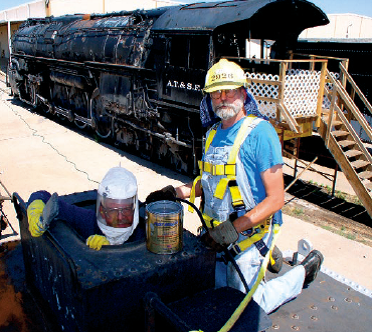
It’s a far cry from his day job. Most Saturday mornings, Mike Hartshorne, M.D., chief of radiology at the Albuquerque, New Mexico Veterans Hospital and professor of radiology at the University of New Mexico (right), dons a Tyvek suit, gloves, and hard hat and straps on a DBI/SALA Stop II safety harness secured to a lifeline. Armed with an Ingersoll-Rand 125 needle-scaler and a flashlight, he climbs down into a confined space that, for many, might feel like the very bowels of hell. “Hell” is the 24,000-gallon water tank of the Santa Fe “2926,” a 60-year-old steam engine locomotive undergoing the painstaking process of restoration, and it’s “one of the four dirtiest places in Albuquerque,” in Hartshorne’s estimation. “Dr. Mike’s” mission on this day is to remove a 3⁄8″ thick layer of calcium carbonate locally known as “caliche” that clings to the metal, along with baked-on grease embedded with sand, plus a gooey, Vaseline-like asphalt, and rust that’s trapped in between the layers of steel in the locomotive’s fuel tender. Bound by a passion for locomotives, Hartshorne and the 20 or so other volunteers who congregate at the jobsite on Wednesdays and Saturdays feel duty-bound to restore the locomotive to its original 1944 running condition. Skilled in jobs that have nothing to do with surface prep and coating — including pastor, policeman, college professor, firefighter, dentist, electrician, auto mechanic, small- business owner, lab technician, and radiologist — they donate hundreds of hours of manual labor. It’s all in the hope that, some six years and $600,000 from now, they will see the “2926” puffing along at 100 mph, pulling excursion trains through the Southwest on tracks owned by Burlington Northern Santa Fe.
One of the Largest, Heaviest, and Most-Powerful Steam Engines
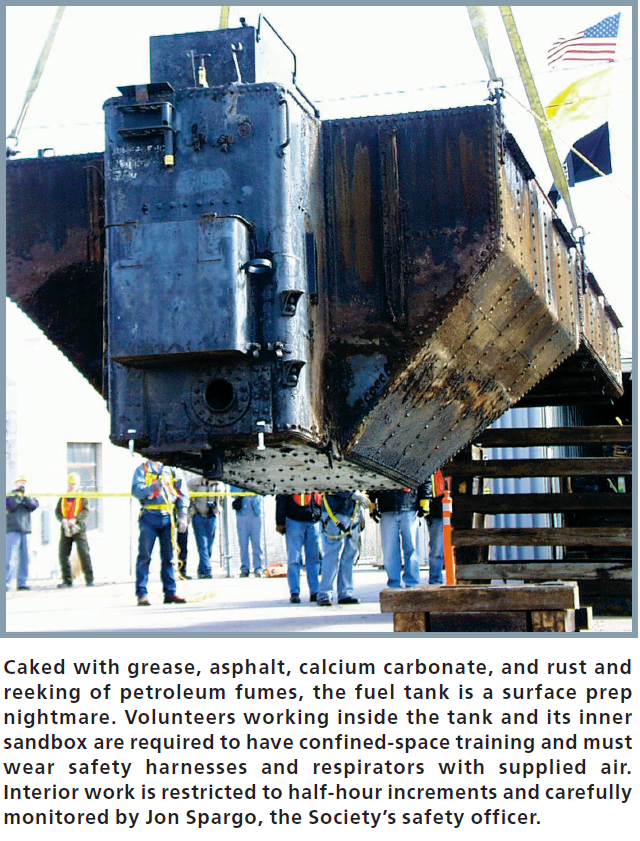
The “2926” is one of 30 “2900-class” engines built by Baldwin Locomotive Works during WWII, at a cost of $252,335. At 121′-long and nearly one million pounds, it was one of the largest, heaviest, and most powerful “4-8-4s” (which refers to the wheel configuration) ever built. Only six of them remain, none operable. Like the “2926,” they’ve been left to crumble in city parks around the country. “There’s been no maintenance on them,” notes Hartshorne. “Every few years, someone slaps a new coat of something black on them.” The “2926” was retired in Albuquerque’s Coronado Park in 1956, where it fell victim to vandals, graffiti taggers, and vagrants who lit fires in her caboose to keep warm at night. Then, in 1999, the 200-member New Mexico Steam Locomotive and Railroad Historical Society (NMSL&RHS) bought the locomotive from the city for $1, and began the mammoth project of amassing money and manpower so that restoration work could begin. Other than a $30,000 grant from the city’s Wheels Museum, which eventually would like to see the locomotive as its centerpiece, the money has trickled in slowly. Bob DeGroft, a 65-year-old retired office-furniture dealer, keeps track of accounting, auditing, insurance, and other administrative functions for the Society. “Some of the money comes from just begging,” he says, pointing out that most charities focus on humanitarian causes rather than restoring a piece of machinery. “Mostly, our donations take the form of old equipment, like a forklift [from Sandia Trailer Sales], and services, which are easier to come by than actual money.” One such service was the June 2000 hauling of the locomotive from Coronado Park onto the track where it’s being restored. It was an intensive three-day job by Jack Messer Construction Co. of Texas that cost $160,000. Says Hartshorne, “We were able to pay about $40,000, and, when I got to be president of the Society, I asked everyone to dig deep to come up with more money. Then one day, I got a call from Jack’s wife in Texas — somebody had sent him a copy of our newsletter. ‘He doesn’t want the money,’ she said. He excused more than $100,000 from what we owed him, and then came back two years later and did some more work for us. All he got was a sign that said, ‘Thanks, Jack.’”
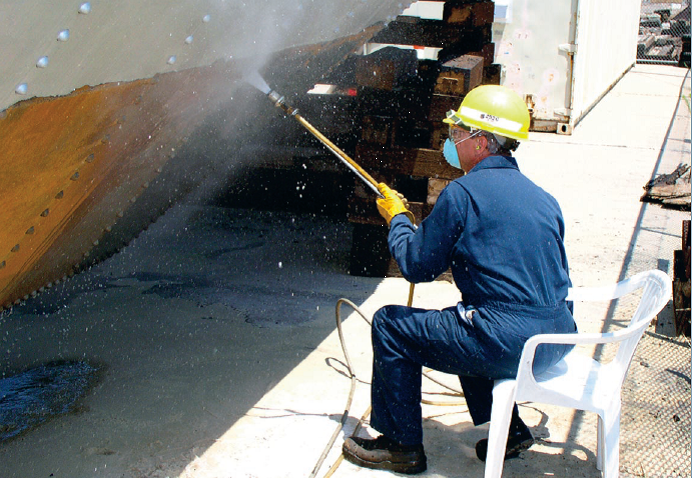
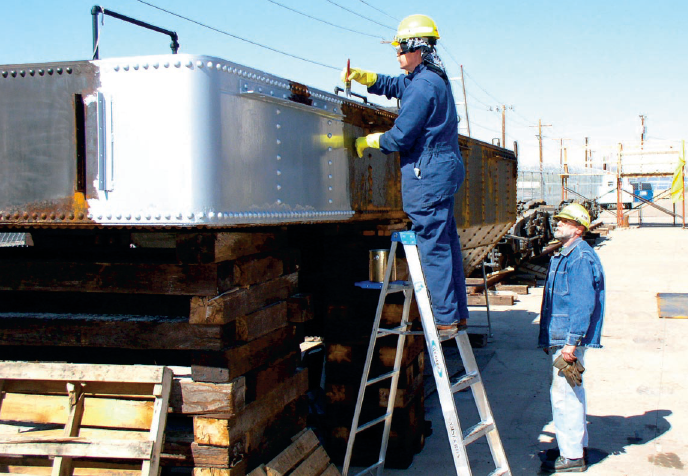
Operating a Troy-Bilt pressure-washing unit equipped with media-blast delivery system (left) is one of the many hands-on jobs tackled by the enthusiastic volunteers, whose weekday professions range from radiologist to pastor. United by a love of steam locomotives, they are devoting hours of manual labor to restore the locomotive to its original condition. A silver coat of Rust Bullet (right) forms an impenetrable layer that protects the heavily riveted-steel fuel tank from corrosion. Originally invented to protect jets’ wingtips from abrasion during flight, the single-component, moisture-cured urethane is brushed, rolled, or sprayed over light rust or clean metal. A second coat will bring the thickness to about 12 mils DFT.
Tackling the Tender
The real fun began in April 2003, when the Society began restoration of the “2926” tender car — a unit attached to the rear of the locomotive used for carrying water and oil. Crane Service Company of Albuquerque donated one of its heavy lift cranes and a crew to hoist the huge oil tank out of the tender car and place it on wood shoring. According to Society members, six decades of paint, mud, oil, grease, and tar encrusted the tank, inside and out, making it difficult to wrest the tank loose. Once it was removed, they started the painful process of scraping, needle-gunning, brushing, sandblasting, and pressure-washing (using a Troy-Bilt Vanguard 9 HP working at 3400 GPM) to remove up to two inches of goo from the surface. For the large surface of the 50-foot tender body, they are considering using a soda-blaster, says Hartshorne. On a sunny Saturday in June, Hartshorne is taking his turn inside the water tank, a classic confined space. He climbs feetfirst through an 18”-diameter hole, rolls over onto his belly, then crawls on his hands and knees some 20 feet over the baffles to a place where he can finally stand up. It’s not a task for the claustrophobic. “The first few times I crawled through the water tank, I wasn’t thrilled about being there,” he says. “Now I almost scamper through it.”
Close Attention to Safety
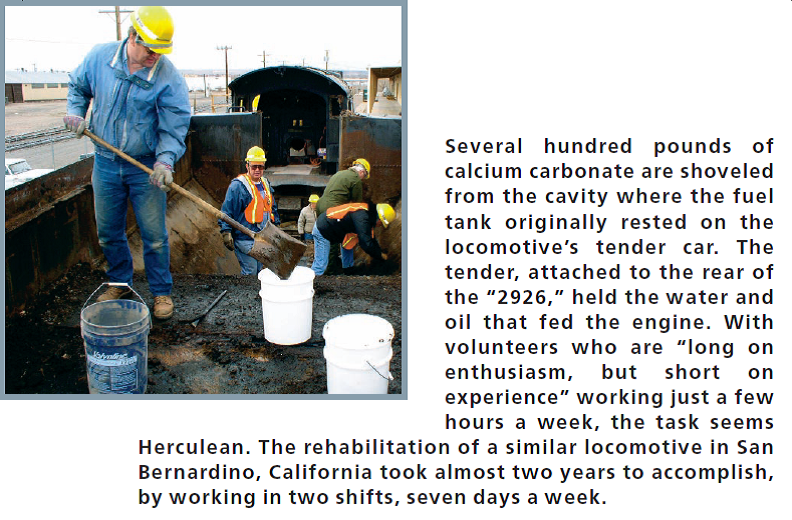
The safety aspects of this job are taken extremely seriously. The volunteer position of safety officer has been assumed by Jon Spargo, safety officer for the Very Large Array (VLA) in Socorro, New Mexico, a series of giant radio telescopes operated by the National Radio Astronomy Observatory. Before any new member is allowed to work on the locomotive, he must undergo a three-hour safety orientation that covers PPE use, HAZMAT, MSDS, and confined-space training, as per OSHA regulations. “We have a lot of folks who are long on enthusiasm, but short on experience,” explains Spargo, who says the process of bringing the volunteers up to OSHA safety standards is “like herding cats.” “I walk a thin line — I don’t want to be overbearing and take the fun out of it, but I also don’t want anyone to get hurt,” he says. “I want us to have the image of being very professional — not a bunch of old geezers playing choo-choo. Otherwise, we won’t get the support we need.” If just one on-the-job injury occurred, “we could kiss the project goodbye,” adds Spargo. Besides OSHA standards, the restoration work must also meet the very stringent safety rules of the Federal Railroad Administration (FRA), as well as the Burlington Northern Santa Fe Railroad, from whom permission will have to be granted to run an excursion service. It won’t be an easy task, because if anything were to go wrong with the excursion train, it would impact the railroad’s ability to carry freight, its chief livelihood. Spargo’s safety efforts are aided by Judy Sadel, a registered nurse and semi-retired firefighter, who has joined her husband, Bob, in becoming “one of the gang.” Clad in overalls, steel-toed work shoes, goggles, mask, and heavy-duty gloves, she willingly attacks the build-up on the tender with whatever tools are needed. When she’s not getting “down and dirty,” Sadel operates a makeshift “rehab station” for the confined-space workers, equipped with a stethoscope, blood- pressure monitor, water, and Gatorade. Spargo invested early on in air-line respirators, safety harnesses, and other safety gear, so that the volunteers don’t ever have to take shortcuts. He restricts confined-space work to half-hour increments, and always has a team standing by to enter if a problem should arise. Sparked by childhood memories of watching steam locomotives pass by, the Sadels, like the other volunteers, are “steam-engine fanatics.” “When all is said and done,” says Sadel, “I can say, ‘I was part of it’ because I was actually doing things with the rest of the crew.”
A Special Coating
After hauling several hundred pounds of caliche out of the tank, Hartshorne and the other volunteers use a pressurewasher modified with a blast-media delivery system to achieve a surface profile of bare metal or light rust. Copper slag from local New Mexico mines is the medium of choice. They’ve opted to paint the surface of the tender with a rust-inhibitive coating called Rust Bullet, which can be applied over light rust, provided the surface is free of dirt and grease, Hartshorne says. Invented 22 years ago by a Los Angeles inventor who worked for NASA, the single-component, hybrid, moisture-cured urethane coating was originally designed for Air Force jets, to protect their wingtips from abrasion during flight, says Bob Murphy, president and CEO of Rust Bullet. Murphy bought the exclusive rights to the patent-pending product from the inventor’s sons and had it tested extensively before bringing it to the coatings market. Using Rust Bullet on the locomotive originated from Bob Kittel of Long Beach, California, who had spearheaded a similar restoration project on the “3751” steam locomotive for the San Bernardino (California) Railroad Historical Society. With his project successfully completed, Kittel now serves as mentor for the Albuquerque project. He had discovered Rust Bullet on the Internet through his other hobby, restoring Model A Fords. “I had used another product, which seemed tough, but it didn’t hold up to UV light or on locomotives,” he says. “A locomotive is a peculiar beast — it runs outdoors and it’s basically a big boiler on wheels, with a lot of steam, water, etc., all of which have detrimental effects.” Rust Bullet’s success on the “3751” led Kittel to recommend it to the NMSL&RHS for the Albuquerque locomotive’s restoration.
An Easy Application
Wearing continuous-flow, sup-plied-air respirators and hoods made by Allegro Industries to protect from isocyanates, volunteer crews apply Rust Bullet with brushes, rollers, and airless sprayers, depending upon the accessibility of the area. The two application product penetrates the porous rust and reaches the metal underneath, transforming isocyanates and water into a polymer matrix that gives off carbon dioxide, according to Murphy. Basically, the rust becomes intertwined in the resin matrix and becomes a permanent part of the coating. A second coat brings the thickness to about 12 mils DFT, fills in pinholes, and forms an impenetrable layer that protects the metal. “It coats gorgeously,” says Hartshorne. “We didn’t trust it at first — one of our volunteers, Paul Uhland, used to be in the Navy, and he said, ‘You can’t paint over rust! It will just trap the rust beneath it.’ So we let it harden and then took a grinder to it. We couldn’t find any rust. There was clean metal under it.” The silver-colored Rust Bullet doesn’t require a topcoat, but will bond well to one if desired for appearance, says Murphy. “When you apply the product, it doesn’t form a film immediately,” he explains. “Instead, it penetrates to combine the rust with the coating all the way down to the original metal surface.” One thing Hartshorne has discovered is that Rust Bullet doesn’t come off skin unless it is removed immediately — his wife had to file a chunk of the coating off his nose with an emery board. He feels that these less-than-pleasant aspects of the job pale in comparison to the fun and camaraderie of working on the locomotive. “I see this as a lifetime project,” he says, looking ahead to the many tasks that took their San Bernardino counterparts almost two years — working seven days a week in two shifts — to accomplish. “I figure I’ll still be doing this when I’m an old man.” CP
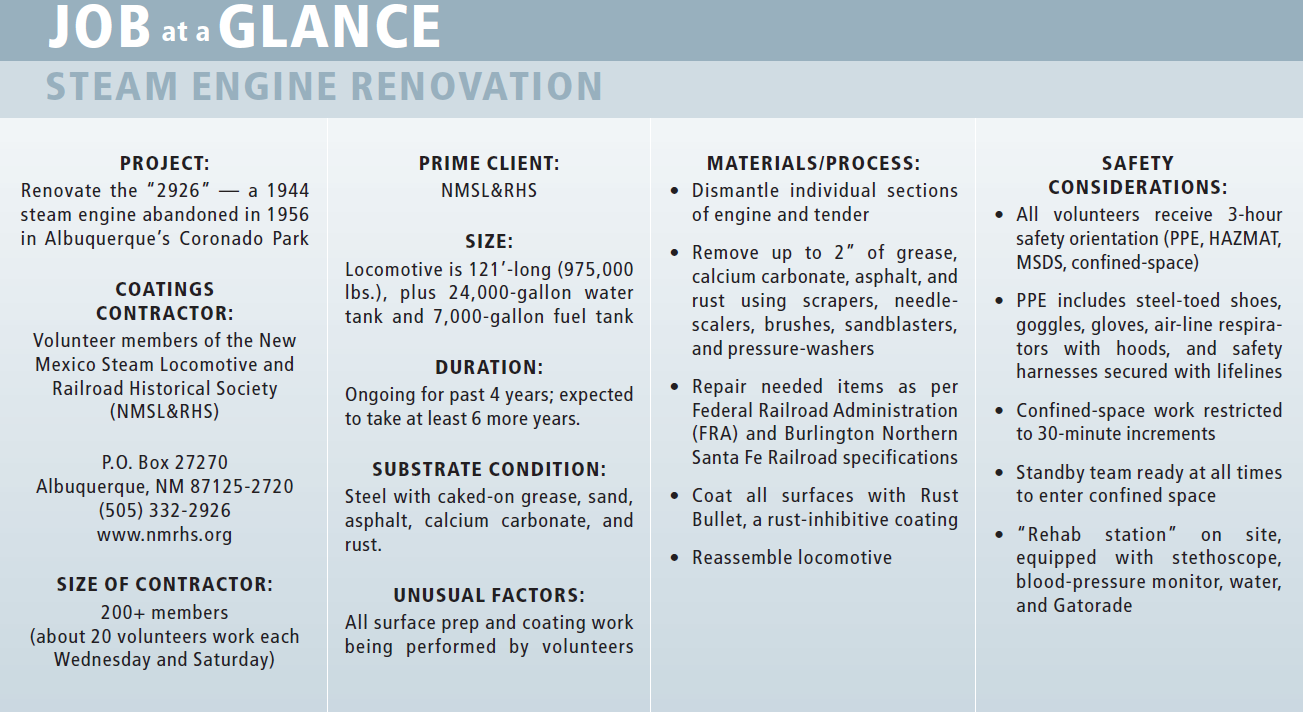
Coatings Pro Magazine, September 2004 – Written By Michele Ostrove
Photos provided by NMSL&RHS & Herb Palmer
]
